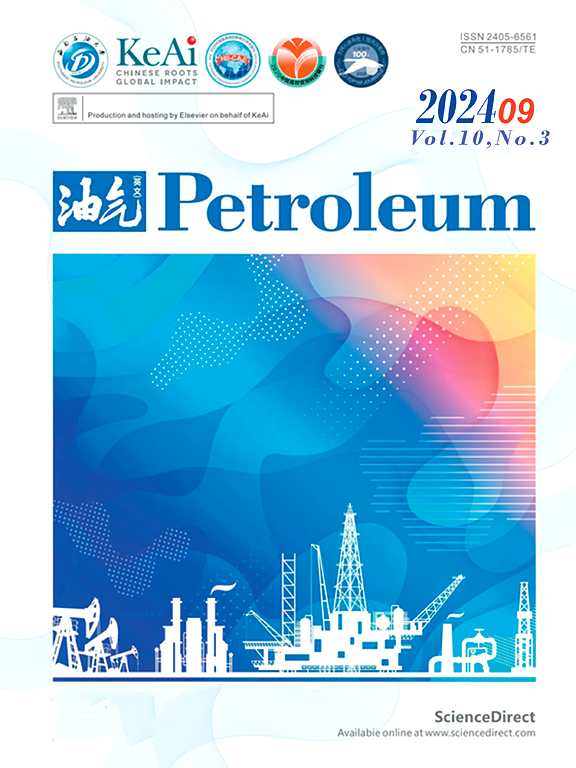通过常规流体特性测量,接近实时地预测水基钻井液滤液体积
IF 4.2
Q2 ENERGY & FUELS
引用次数: 0
摘要
钻井作业依赖于精确控制钻井液滤过量(FV),而FV会影响地层完整性、成本和井眼稳定性。保持最佳FV对于防止井控问题至关重要,但由于工艺复杂性和测量限制,预测FV具有挑战性。该研究采用机器和深度学习(ML/DL)模型,基于更容易测量的流体特性,几乎实时地预测FV。径向基函数神经网络(RBFNN)、广义回归神经网络(GRNN)、多层感知器(MLP)、卷积神经网络(CNN)和高斯过程回归(GPR) ML模型应用于14口井中部署的水基钻井液的密度、粘度和固体含量的1186条记录。与RBFNN和GRNN不同,CNN以最低的均方根误差(RMSE) 0.5381 mL优于其他模型,并表现出对过拟合和噪声数据的弹性。该方法提供了可靠的近实时FV预测,有助于通过防止潜在的钻井液相关问题来优化钻井作业。从常规流体性质中快速准确地预测FV是钻井作业的重要进步,强调了未来数据集扩展的需求,以涵盖更广泛的条件和流体类型。本文章由计算机程序翻译,如有差异,请以英文原文为准。
Predicting water-based drilling fluid filtrate volume in close to real time from routine fluid property measurements
Drilling operations depend on precisely controlling drilling fluid filtration volume (FV), which affects formation integrity, costs, and borehole stability. Maintaining optimal FV is essential to prevent well control issues, yet forecasting it is challenging due to process complexity and measurement limitations. This study adapts machine and deep learning (ML/DL) models to predict FV in almost real-time based on more easily measured fluid properties. Radial-basis-function neural network (RBFNN), generalized regression neural network (GRNN), multilayer perceptron (MLP), convolutional neural network (CNN), and Gaussian process regression (GPR) ML models are applied to 1186 records of density, viscosity, and solids content in water-based drilling fluids deployed in fourteen wellbores. CNN outperformed other models with the lowest root mean square error (RMSE) of 0.5381 mL and demonstrated resilience to overfitting and noisy data, unlike RBFNN and GRNN. The proposed method provides reliable near-real-time FV predictions, which could be beneficial in optimizing drilling operations by helping prevent potential drilling-fluid-related issues. Fast and accurate FV forecasting from routine fluid properties represents a crucial advancement for drilling operations, highlighting the need for future dataset expansion to encompass a wider range of conditions and fluid types.
求助全文
通过发布文献求助,成功后即可免费获取论文全文。
去求助
来源期刊

Petroleum
Earth and Planetary Sciences-Geology
CiteScore
9.20
自引率
0.00%
发文量
76
审稿时长
124 days
期刊介绍:
Examples of appropriate topical areas that will be considered include the following: 1.comprehensive research on oil and gas reservoir (reservoir geology): -geological basis of oil and gas reservoirs -reservoir geochemistry -reservoir formation mechanism -reservoir identification methods and techniques 2.kinetics of oil and gas basins and analyses of potential oil and gas resources: -fine description factors of hydrocarbon accumulation -mechanism analysis on recovery and dynamic accumulation process -relationship between accumulation factors and the accumulation process -analysis of oil and gas potential resource 3.theories and methods for complex reservoir geophysical prospecting: -geophysical basis of deep geologic structures and background of hydrocarbon occurrence -geophysical prediction of deep and complex reservoirs -physical test analyses and numerical simulations of reservoir rocks -anisotropic medium seismic imaging theory and new technology for multiwave seismic exploration -o theories and methods for reservoir fluid geophysical identification and prediction 4.theories, methods, technology, and design for complex reservoir development: -reservoir percolation theory and application technology -field development theories and methods -theory and technology for enhancing recovery efficiency 5.working liquid for oil and gas wells and reservoir protection technology: -working chemicals and mechanics for oil and gas wells -reservoir protection technology 6.new techniques and technologies for oil and gas drilling and production: -under-balanced drilling/gas drilling -special-track well drilling -cementing and completion of oil and gas wells -engineering safety applications for oil and gas wells -new technology of fracture acidizing
 求助内容:
求助内容: 应助结果提醒方式:
应助结果提醒方式:


